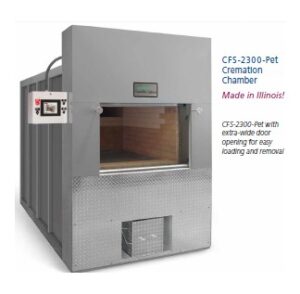 Research the current market conditions for starting an on-site Pet Cremation service from an economic, sales and marketing standpoint.
Research the current market conditions for starting an on-site Pet Cremation service from an economic, sales and marketing standpoint.
- How far is the competition?
- The timeframe for returning cremated remains of pets is getting longer and more costly. Can your facility help to lower the return time?
- Assess whether the cost of entry and future operating expense generate enough earnings for a successful long-term business. Write a business plan and share it with an accountant or financial advisor. Pet cremation is not a “get rich quick” business investment.
- How much are you spending on 3rd party cremation costs if you are using 3rd party pet cremation?
- Consider the price/cremation, travel time to and from crematory, scheduling conflicts, legal liability, insurance, salaries, gas, operating costs, etc. when using a 3rd party cremation provider.
- Will you provide cremations for your own veterinary clinic, collaborate with other clinics, or be open to the community?
- Will you provide a pick-up service at personal residences and/or other vet clinics? Will you need vehicles and drivers?
- Will you offer additional services? Euthanasia services: in-home or at business location only? Grooming services for those who want to see their pet prior/during the cremation process?
- Do you have a properly zoned building for pet cremation?
- Understanding and succeeding with local planning and zoning officials can be a difficult process. Review local and planning code to see if your property and zoning is a permitted use for cremation. Get this zoning and cremation ruling in writing from the local authorities.
- If cremation is not a permitted use, inquire if a Special Use permit can be obtained. Evaluate the planning and zoning staff response on a Special Use permit request to allow cremation at your location has any success. NOTE: public notice and public hearings related to cremation can create excessive local emotion and negative perceptions of your business. Your customers want cremation but generally not in their neighborhood.
 Have existing structures on-site evaluated for a cremation chamber that meets local code. If that is not possible, secure a location with excellent access to highways for animal transport in and cremated remains return.
Have existing structures on-site evaluated for a cremation chamber that meets local code. If that is not possible, secure a location with excellent access to highways for animal transport in and cremated remains return.
- Factors to consider: Door size, 8’x8’ minimum, Ceiling Height minimum 8’-6”, Total Floor Area (normally 12’ wide x 21’-6” long), Utility Locations, Natural Gas, Propane, Electrical, Internet Access, Roof Height, and Stack Elevation with respect to crematory and surrounding buildings.
- If a new crematory area is being designed, make sure there is enough space for refrigeration, cremated remains processing and safe storage of cremation containers/boxes/urns.
- Evaluate local crane and rigging contractors’ ability to unload, position and erect the stack of your retort. How does this compare with using the retort manufacturer as a Turnkey Installer of your investment?
- Determine what cremation chamber fits your current and future cremation needs.
- How many cremations do you forecast annually and in 5 years?
- Will you be performing mostly private, semi-private or communal cremations?
- Will you be catering to domestic animals or larger farm animals as well?
- Will you have a viewing window so customers can witness their pets being cremated? Private, viewed pet cremations are the highest revenue per customer.
- What is the maximum animal size and communal cremation volume you are forecasting for your cremation market? Many retorts are rated at 250, 300, 400, 500, 800 and 1000 lb capacities.
- Based on your location and proximity to cremation chamber technical service and repair, should your cremation equipment be connected to the Internet for remote diagnostics and individual cremation case assistance when necessary?
- How easy are the normal consumable parts to change? How often do they need to be replaced? (Thermocouples, Ignitors, Flame Safety Scanners, etc.) Can the crematory operator do these maintenance repairs, or must the manufacturer be involved?
- Check with state and local Departments of Environmental Quality on the specification of air emission operating parameters. Many states have specific Secondary or Afterburner temperature requirements that must be shared with the retort manufacturer before installation.
- Check your states’ regulations and consider the different governing agencies that you may have to consult with or be licensed by. This could be dependent on the type of animals you plan to euthanize/cremate at your facility. (Department of Natural Resources, Department of Agriculture, Environmental Protection Agency, etc.)
- Consult your legal counsel regarding the liability issues regarding cremation. Ask your insurance agent about the coverage needed for your facility.
- Take a Certified Pet Crematory Operator class before performing your first cremation. This investment in your business and staff may be required in some states but is very informative regarding operation, procedures, chain of custody and business aspects of cremation. This course is offered in person and online by the Cremation Association of North America in conjunction with the International Association of Pet Cemeteries and Crematories. The cost for members is roughly $500, nonmembers, $600.
- Establish credibility with individuals within your community and the surrounding areas.
- Providing exceptional veterinary services to current customers is crucial to when it comes to end-of-life decision making.
- When a pet is cremated, follow up. Send a condolence letter signed by your team, newsletters, etc. 70% of households owned at least one pet in 2022, many will own multiple pets over a lifetime. Assuring one family’s business could also mean valuable word of mouth referrals.
- Providing reliable, consistent, respectable service is crucial to succeeding in the industry.
If you have any other questions regarding the technical aspects of operating and owning a pet retort, please contact Cremation Systems at 708 339 6810 or www.cremsys.com.